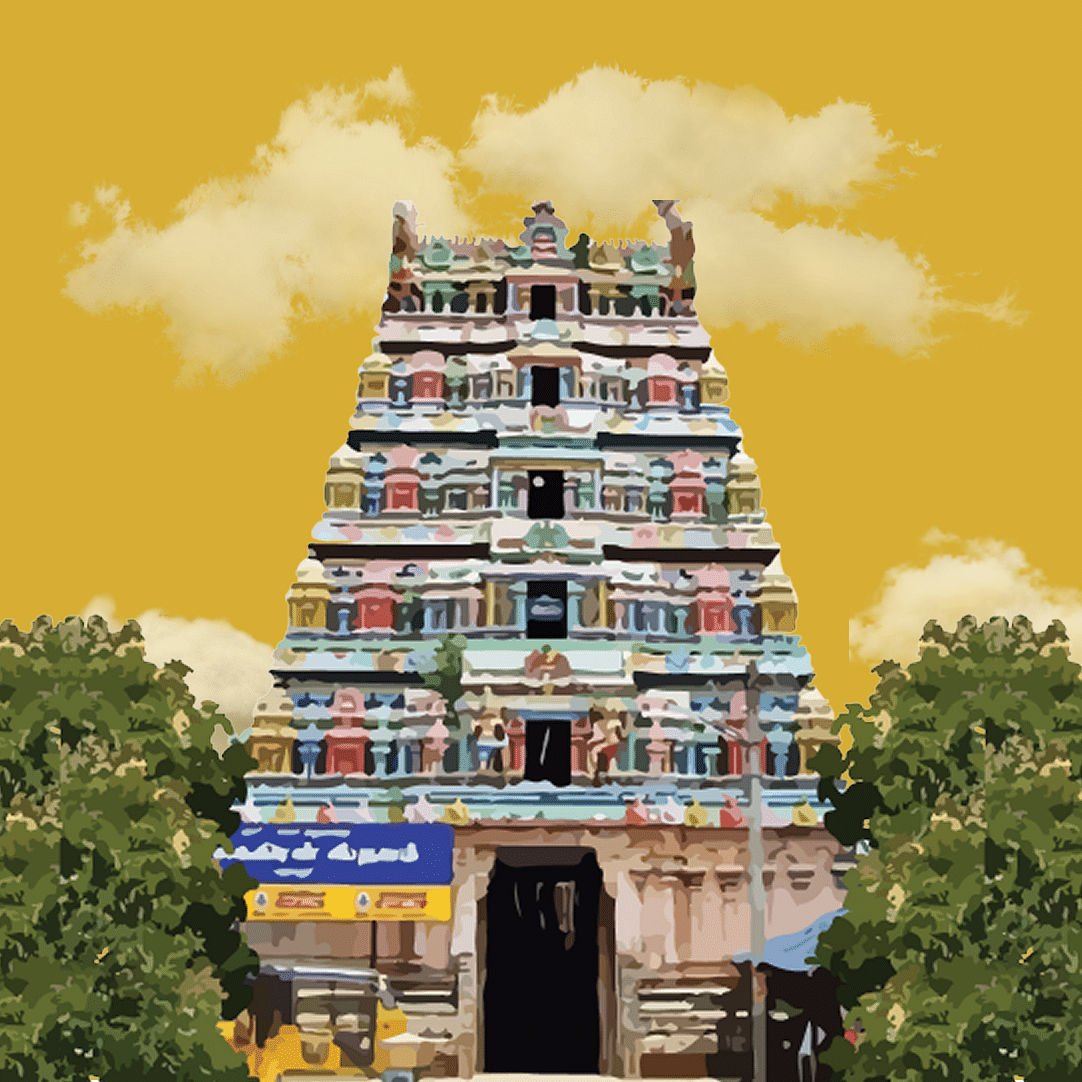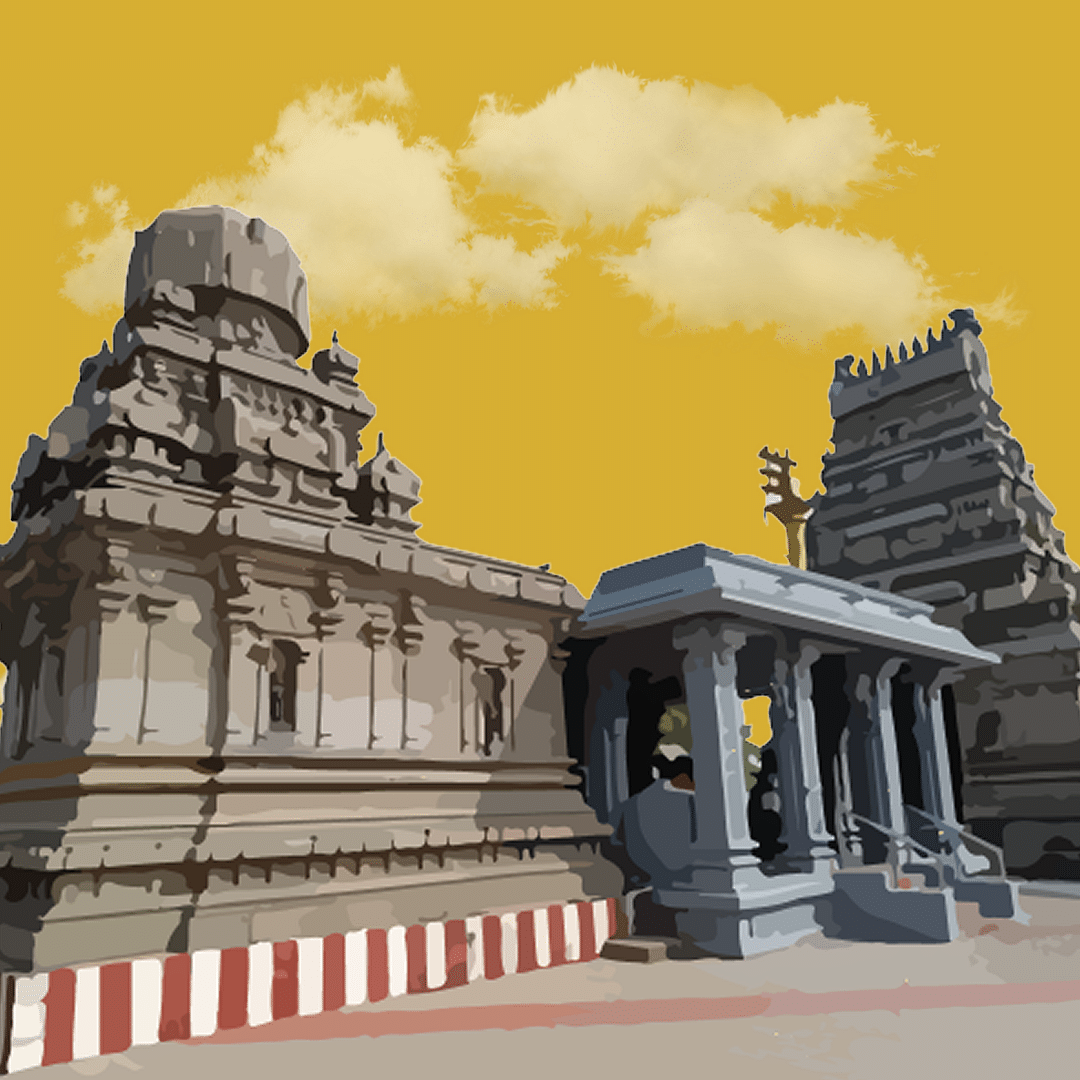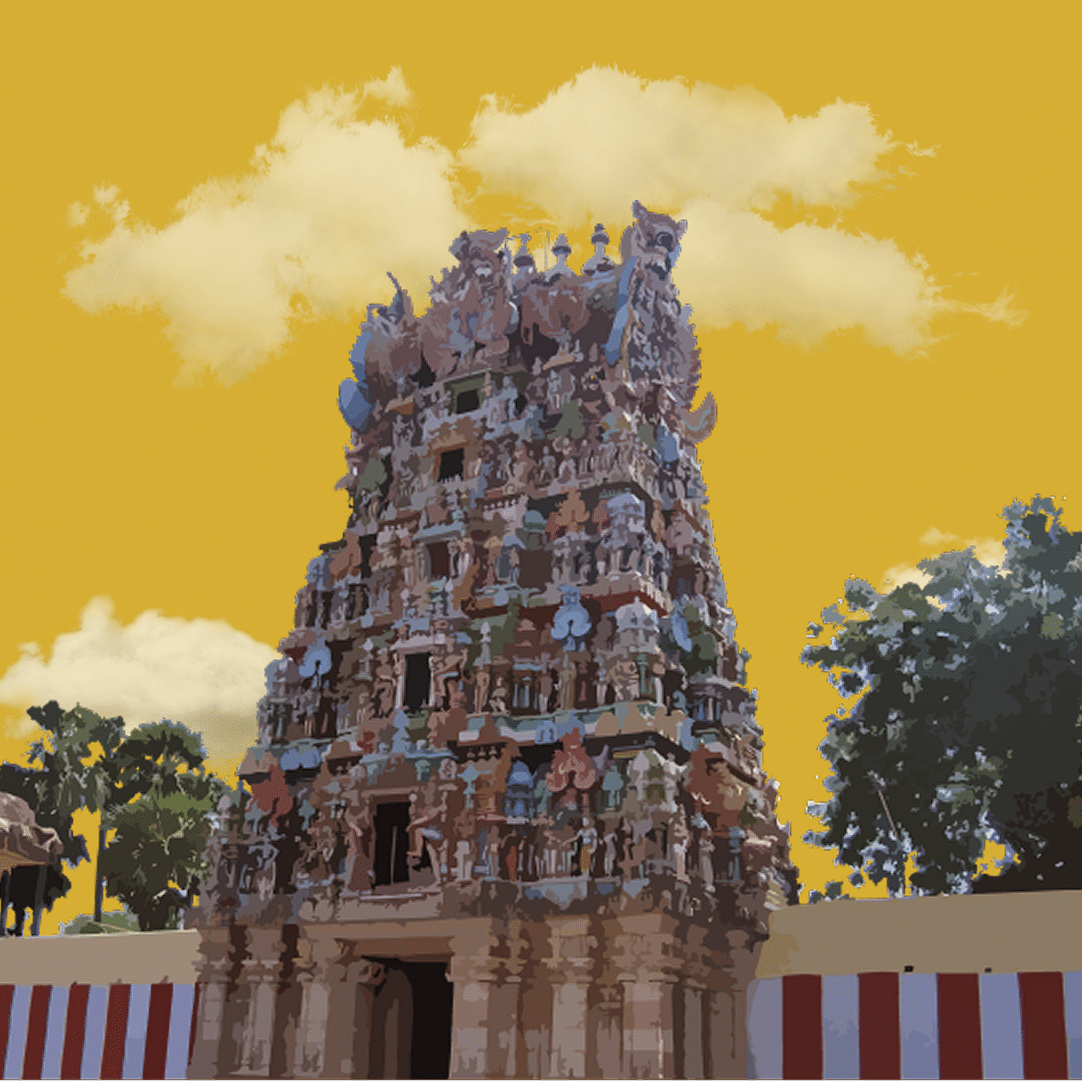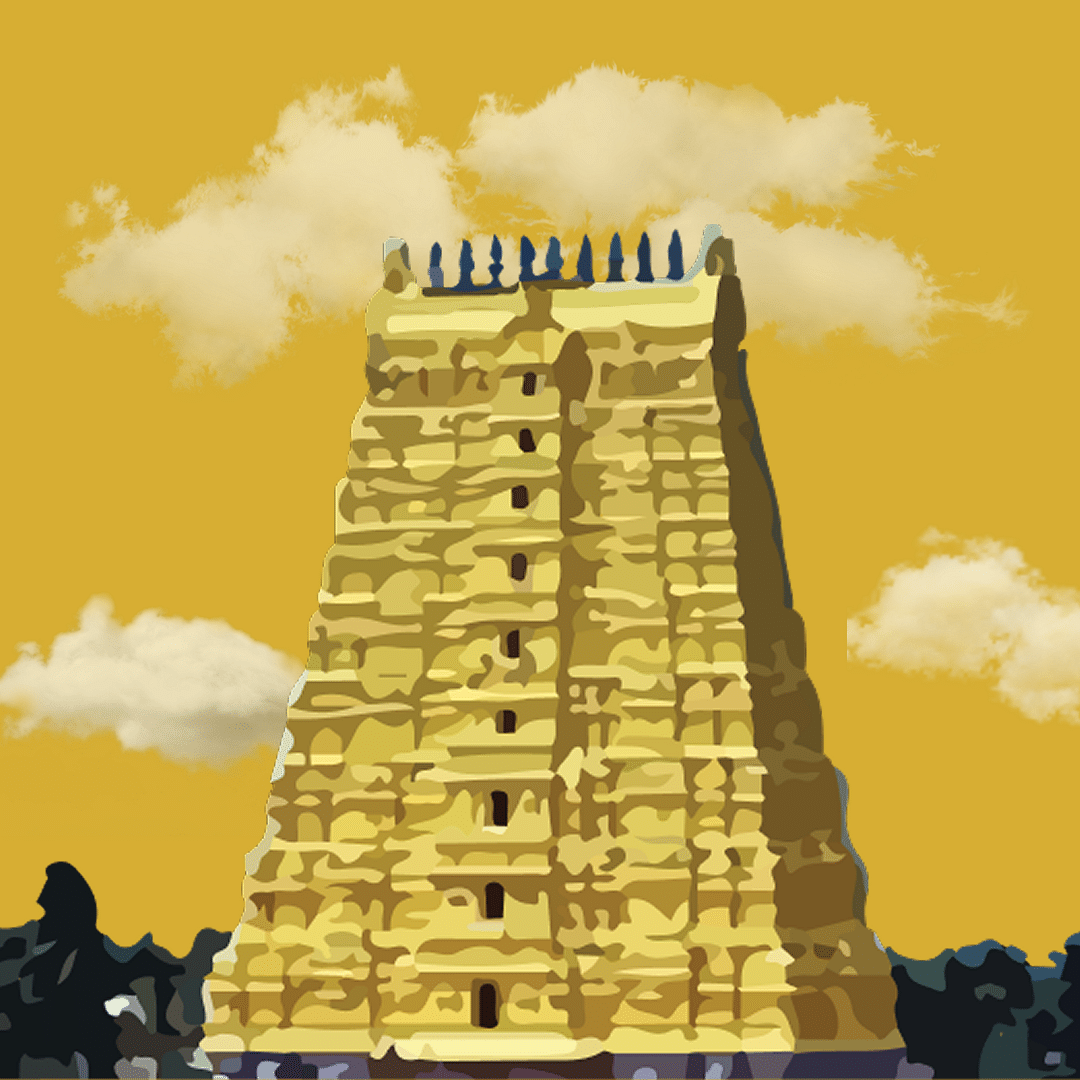Home > The GReaT Divine Darshan > Chennai
HOLY PLACES
IN CHENNAI
Chennai isn’t just a city; it’s a feeling—one that lingers like the scent of jasmine in the evening breeze. At dawn, the Bay of Bengal whispers against golden shores while the city stirs to the aroma of filter coffee and crisp dosas. Here, colonial-era charm meets a buzzing metropolis of IT hubs, cafes, and artsy boutiques. Bharatanatyam dancers move with timeless grace, and Carnatic melodies weave through the streets, echoing the city's deep-rooted heritage. From ancient temples to modern-day marvels, the city embraces modernity with open arms, seamlessly blending past and present. As twilight paints the sky in hues of saffron and gold, you realise Chennai is an experience that stays with you, like the echo of temple bells at dawn.
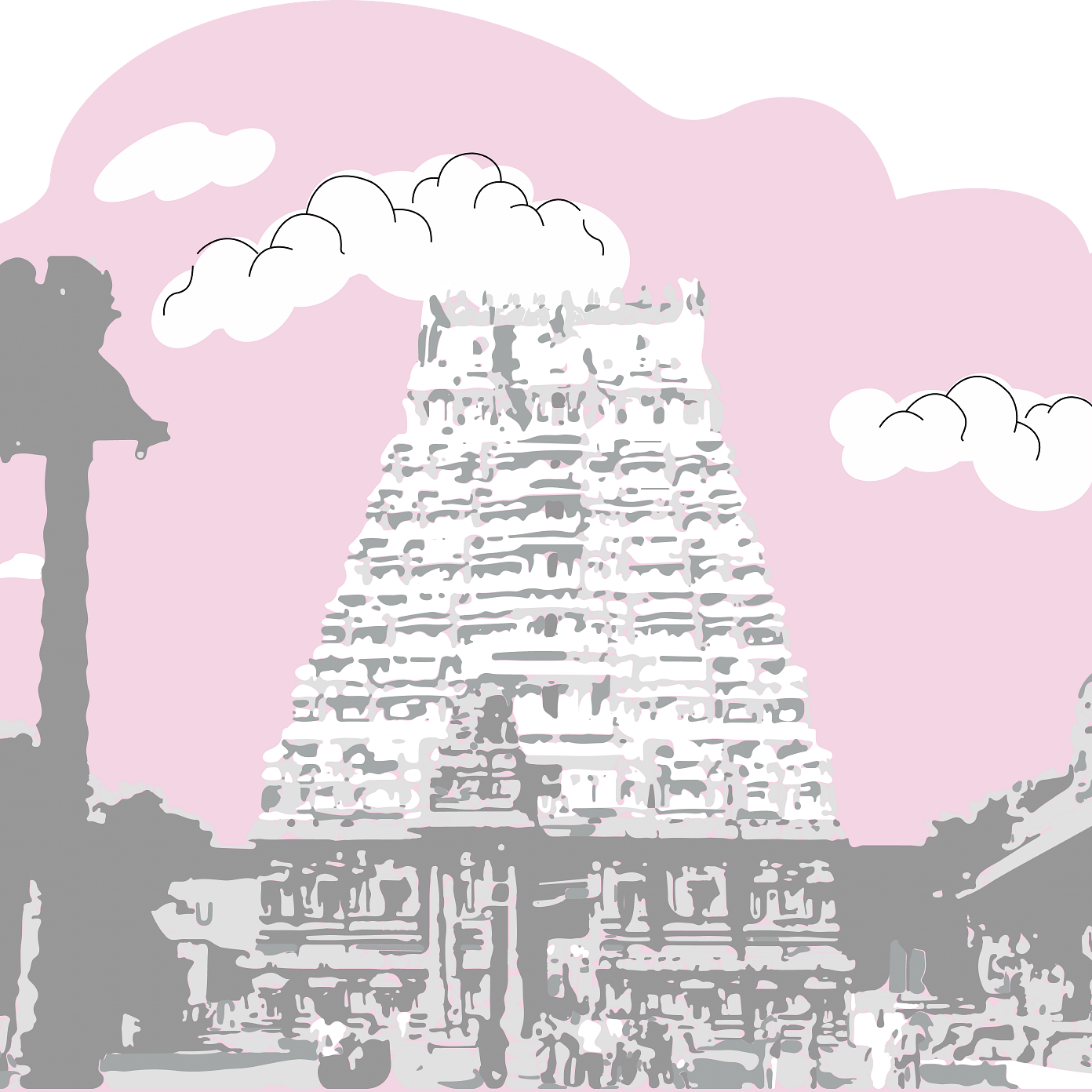
 OUR Hotels
OUR Hotels
IN THE CITY, BY THE SACRED SITES 🏙

Grand Chennai by GRT Hotels
Welcome to Grand Chennai by GRT Hotels, where the city’s energy meets effortless elegance! Nestled in the heart of T. Nagar, we’re the pioneers of GRT’s legendary hospitality. Step inside, and you’re in for a treat—133 luxurious rooms, a trio of culinary hotspots, and nine grand banquet halls for every celebration imaginable. But wait, there’s more! Glide up in Chennai’s first-ever capsule lift, because why just go up when you can level up? Whether you’re here for business or leisure, we make every stay unforgettable. And with Chennai’s best shopping, dining, and cultural gems just a stone’s throw away, you’re always in the midst of the action. Come, experience the soul of Chennai hospitality, where every moment is nothing short of GReaT!

Radisson Blu Hotel & Suites GRT Chennai
At Radisson Blu Hotel and Suites GRT Chennai, luxury isn’t just what you see—it’s what you feel. Just 4 km from Chennai International Airport, we make every arrival effortless with complimentary airport transfers. From the moment you step in, the experience begins! Step into a world where nature meets elegance, with lush indoor terrariums and tranquil suites designed to refresh your senses. Craving something extraordinary? Savour Anglo-Indian delights at Ministry of Chutneys, indulge in smoky, succulent kebabs at The Great Kabab Factory, or enjoy Tamil street food with a gourmet twist at Kari Theory. Relax at Bodhi Spa, home to Chennai’s only Turkish hammam, or take a dip in our Salt Splash pool. Got an event on the horizon? Our elegant Royal Ballroom is where memorable moments come to life. For work or play, your stay will be truly GReaT!
 OURDivine Destinations
OURDivine Destinations
TRAVEL THROUGH THE MUSEUMS OF FAITH 🛕
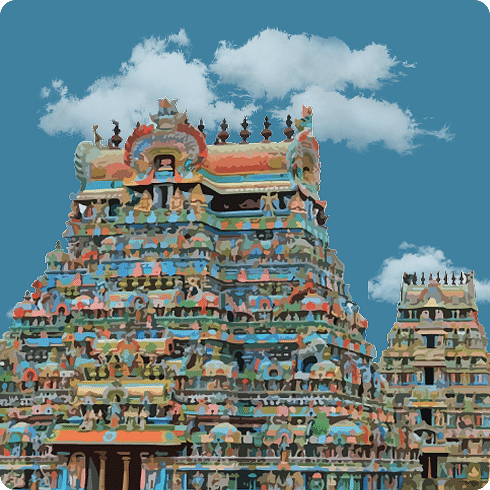
KAPALEESHWARAR TEMPLE ✨
Dating back to the 7th century AD, this architectural marvel dedicated to Lord Shiva and Goddess Karpagambal. It stands as a timeless testament to why temples in Chennai are known for spiritual heritage.
Distance from Grand Chennai6 km
Timing6:00 a.m. to 12:00 p.m.
4:00 p.m. to 9:00 p.m.FestivalPanguni Brahmotsavam: (Mar)
Arupathimoovar Festival: (Mar-Apr)
Vasantha Utsavam: (Mar-Apr)Sacred Food OfferedSakkarai Pongal
Transportation CostFor assistance, please contact the front desk.
Disclaimer: The temple's timings are subject to change as per the operating committee's decisions.
About Kapaleeshwarar Temple:
- The Kapaleeshwarar Temple, dedicated to Lord Shiva, is a landmark of Dravidian architecture in Mylapore, Chennai.
- The temple’s name comes from ‘Kapalam’ (skull) and ‘Eshwarar’ (Lord Shiva), linked to the legend of Shiva plucking a head of Lord Brahma.
- The Shiva Lingam here is a Swayambhu Lingam, meaning it is self-manifested, making it one of the most sacred in the world.
- The temple is famous for its towering 37-metre-high gopuram, adorned with vibrant mythological sculptures.
- Goddess Parvati, worshipped as Karpagambal, is believed to have taken the form of a peahen here to seek Lord Shiva’s blessings.
- The temple’s Punnai tree is centuries old and is revered as the site where Goddess Parvati performed penance.
- The annual Panguni Brahmotsavam festival, held in March–April, is one of the grandest in Chennai, drawing thousands of devotees.
- The Arubathimoovar festival, honouring the 63 Nayanmar saints, features a vibrant procession that is a visual and spiritual spectacle.
- The temple’s sacred tank, located near the western entrance, is believed to have divine healing properties.
- The temple has been praised in Thevaram hymns by revered Shaivite saints, adding to its spiritual significance.
Divine Facts:
Long ago, Goddess Parvati wished to understand the profound essence of the sacred mantra ‘Na Ma Shi Va Ya’. As Lord Shiva explained its meaning, Parvati was momentarily distracted by a graceful peahen dancing nearby. In his divine play, Shiva, displeased, cursed her to become a peahen until she performed penance. Devoted and unwavering, Parvati worshipped Lord Shiva beneath the sacred Punnai tree in Mylapore, where the temple stands today. Moved by her penance, Shiva forgave her and restored her divine form. Thus, the place came to be known as Mylapore (‘Mayil’ meaning peahen in Tamil). Even today, a shrine in the temple courtyard depicts Goddess Karpagambal in peahen form worshipping Lord Shiva, a timeless reminder of devotion, grace, and divine mercy.PARTHASARATHY TEMPLE ✨
Believed to be over 1,400 years old, this sacred temple stands as a testament to Chennai’s rich spiritual heritage.
Distance from Grand Chennai6 km
Timing6:00 a.m. to 12:00 p.m.
4:00 p.m. to 8:00 p.m.FestivalChithirai Brahmotsavam: (Apr-May)
Vasanthotsavam: (Apr-May)
Narasimhaswamy Brahmotsavam: (Mar)
Krishna Jayanthi: (Aug-Sep)
Navarathri: (Sep-Oct)
Pavitrotsavam: (Jul)
Deepavali: (Oct-Nov)
Karthigai Deepam: (Nov-Dec)
Margazhi Utsavam: (Dec-Jan)
Masi Magam: (Feb-Mar)
Panguni Uthram: (Mar-Apr)Sacred Food OfferedAkkaravadisal, Puliyodarai, Adirasam, Sojji Appam, and Thenkuzhal
Transportation CostFor assistance, please contact the front desk.
Disclaimer: The temple's timings are subject to change as per the operating committee's decisions.
About Parthasarathy Temple:
- The Parthasarathy Temple, dedicated to Lord Vishnu, is one of the 108 Divya Desams glorified in the Tamil hymns of the Alvar saints.
- The temple is named after Parthasarathy, meaning ‘Charioteer of Arjuna’ referring to Krishna’s role in the Mahabharata.
- Unlike most Vishnu temples, here Krishna appears with a moustache and without his Sudarshana Chakra (discus), signifying his role as a charioteer rather than a warrior.
- The temple was originally built by the Pallava king Narasimhavarman I in the 6th century AD, making it one of the oldest structures in Chennai.
- It houses five forms of Vishnu: Yoga Narasimha, Rama, Gajendra Varadaraja, Ranganatha, and Krishna as Parthasarathy.
- The Rajagopuram (temple tower) is a grand example of Dravidian architecture, adorned with intricate carvings of mythological figures.
- The temple tank, Kairavani Pushkarini, is believed to have water more sacred than the Ganges, with five holy theerthams surrounding it.
- The annual Vaikunta Ekadashi festival is a major event where 4,000 Tamil hymns (Divya Prabandham) are recited in praise of the deity.
- The temple’s mandapams (pillared halls) are adorned with carvings that depict various scenes from the Ramayana and Mahabharata.
- The deity bears scars on his face, believed to be from the arrows of Bhishma during the Kurukshetra war, a unique feature not seen in other Krishna temples.
Divine Facts:
Parthasarathy Temple stands in what was once known as Brindaranya Kshetram, a holy tulsi forest where sages and celestial beings performed penance. According to legend, the seven great sages (Saptarishis) worshipped the five Vishnu forms here, making it a powerful spiritual site. It is also said that King Sumati, a devoted ruler, prayed fervently to witness Krishna in his Parthasarathy form. In divine grace, Krishna appeared before him along with his consort Rukmini, his brother Balarama, and his descendants Pradyumna, Aniruddha, and Satyaki—a rare assembly of the Yadava lineage. Even today, the temple’s sanctum enshrines this divine family, offering devotees a glimpse into Krishna’s life beyond the battlefield.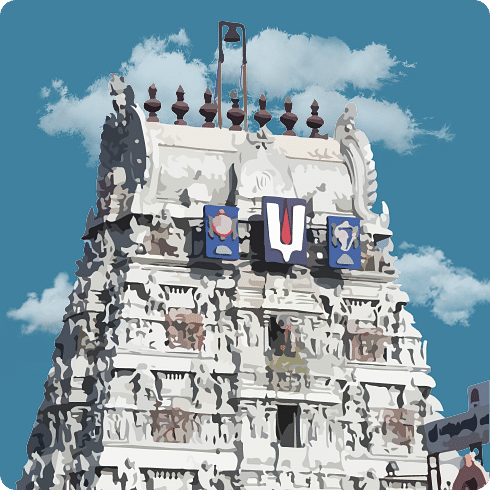
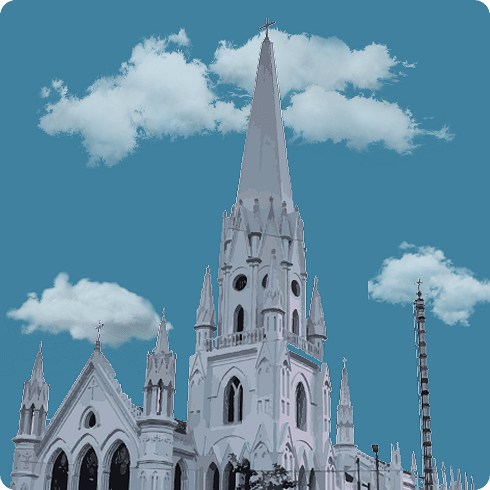
SANTHOME CHURCH ✨
Believed to be built over the tomb of Saint Thomas, this awe-inspiring neo-Gothic basilica in Chennai stands as a sacred testament to faith, history, and architectural grandeur!
Distance from Grand Chennai7 km
Timing6.00 a.m. to 8.00 p.m.
FestivalChristmas: (Dec)
New Year: (Dec-Jan)
Easter: (Apr)
Mylai Madha Festival: (Dec)
All Souls Day: (Nov)Transportation CostFor assistance, please contact the front desk.
Disclaimer: The church's timings are subject to change as per the operating committee's decisions.
About Santhome Church:
- Santhome Basilica, officially known as St. Thomas Cathedral Basilica, is built over the tomb of St. Thomas the Apostle, one of the twelve apostles of Jesus Christ.
- It is one of only three churches in the world built over the tomb of an apostle, the others being St. Peter’s Basilica in Vatican City and Santiago de Compostela Cathedral in Spain.
- Originally constructed by the Portuguese in 1523, the church was later rebuilt by the British in 1896 in a stunning Neo-Gothic architectural style.
- The white facade, towering spire, and stained-glass windows give the basilica a majestic appearance, making it a landmark in Chennai.
- A museum within the church showcases significant relics, including the spearhead that martyred St. Thomas, his fingerprint, and historical artefacts.
- The underground Tomb Chapel, where St. Thomas is believed to be buried, is a revered site of prayer and pilgrimage.
- The basilica’s stained glass windows depict scenes from the life of St. Thomas and other apostles of Jesus.
- Marco Polo, the famous Venetian traveller, visited the tomb in 1292 and recorded its miraculous healing powers.
- Pope John Paul II visited and prayed at the tomb during his visit to India in 1986.
- The church continues to be an important centre for Christian worship and attracts visitors from around the world for its historical and religious significance.
ASHTALAKSHMI TEMPLE ✨
Perched along the serene shores of Elliot’s Beach, the Ashtalakshmi Temple is a divine tribute to Goddess Lakshmi and her eight manifestations, bestowing blessings of wealth, prosperity, courage, and wisdom!
Distance from Grand Chennai10 km
Timing6:30 a.m. to 12:00 p.m.
4:00 p.m. to 8:00 p.m.FestivalNavaratri: (Sep-Oct)
Deepavali: (Oct-Nov)
Pongal: (Jan)
Mahotsavam: (Dec)
Karthigai Masam: (Nov-Dec)Sacred Food OfferedAthirasam and Laddu
Transportation CostFor assistance, please contact the front desk.
Disclaimer: The temple's timings are subject to change as per the operating committee's decisions.
About Ashtalakshmi Temple:
- The Ashtalakshmi Temple, situated on the shores of Elliot’s Beach in Chennai, is dedicated to Goddess Lakshmi and her eight divine forms.
- It is one of the rare temples in India where all eight forms of Lakshmi are enshrined together, each bestowing unique blessings upon devotees.
- The temple was built in 1976 on the wishes and blessings of Sri Chandrasekarendra Saraswati Swamigal of Kanchi Mutt.
- The architectural design is inspired by the Sundararaja Perumal Temple in Uthiramerur and follows the sacred Ashtanga Vimana style.
- The sanctums are arranged in a multi-tiered structure, allowing devotees to visit all shrines without stepping over any other sanctum.
- The main sanctum houses idols of Mahalakshmi and Mahavishnu, standing at seven feet tall, facing the Bay of Bengal.
- The temple follows the Aarukala Pooja system, with six daily poojas performed in adherence to Vedic traditions.
- Special poojas are conducted on Fridays during the Tamil months of Thai (January–February) and Aadi (July–August), considered highly auspicious for Goddess Lakshmi.
- The Sthala Vriksham (sacred tree) of the temple is the Vilvam, a rare choice for a Lakshmi temple, as it is traditionally associated with Lord Shiva.
- Unlike many temples, this one does not have a traditional temple tank, as it is located close to the Bay of Bengal, which is considered the temple’s sacred water source.
- The temple is particularly vibrant during Navratri, Deepavali, and Pongal, when it is adorned with lights, flowers, and devotional music.
Divine Facts:
Long ago, when the cosmic forces of the universe were at odds, a great event unfolded—the Samudra Manthan, the churning of the Milky Ocean. The Devas (celestial beings) and Asuras (demons) came together in search of Amrit, the nectar of immortality. As the ocean swirled in a dance of creation and chaos, magnificent treasures emerged, each holding divine significance. But amidst the dazzling wonders, a radiant goddess arose from the depths—the embodiment of prosperity, purity, and grace—Goddess Lakshmi. Draped in shimmering gold with a celestial glow brighter than a thousand suns, she brought with her wealth, success, and boundless fortune. The moment her lotus-like feet touched the ground, flowers bloomed, rivers sparkled, and the heavens rejoiced. The gods and sages bowed in reverence, for they knew she was the very essence of divine abundance. Without hesitation, she chose Lord Vishnu, the protector of the universe, as her eternal consort, promising to bestow prosperity upon all who upheld righteousness. But her blessings were not singular—they were manifold. As time passed, her divine energy manifested in eight sacred forms, each fulfilling a different need of life. She became Adi Lakshmi, the source of all existence, and Dhana Lakshmi, the giver of wealth. She bestowed nourishment as Dhanya Lakshmi, strength as Veera Lakshmi, and victory as Vijaya Lakshmi. For those yearning for wisdom, she emerged as Vidya Lakshmi, while Santana Lakshmi blessed families with children, and Gaja Lakshmi ensured royal power and prosperity. It is believed that the Ashtalakshmi Temple in Chennai stands as a celestial reminder of this divine promise. Facing the vast Bay of Bengal, the very ocean from which she emerged, this temple is where devotees experience the goddess’s eternal presence. When the sea breeze carries the temple bells' chimes and the fragrance of incense fills the air, it is said that Lakshmi walks among her devotees, listening to their prayers, granting them wealth—not just of riches but of knowledge, courage, and happiness. Even today, those who seek her blessings at this sacred temple feel an unseen force guiding them towards a life of abundance and fulfilment, as if Lakshmi herself smiles upon them, whispering: ‘True wealth is not just in gold, but in the goodness of one’s heart and the purity of one’s soul.’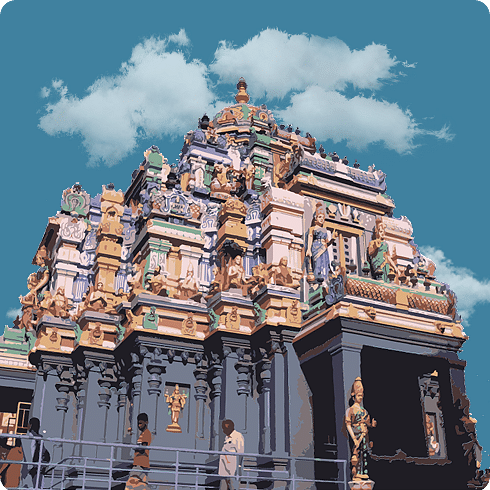
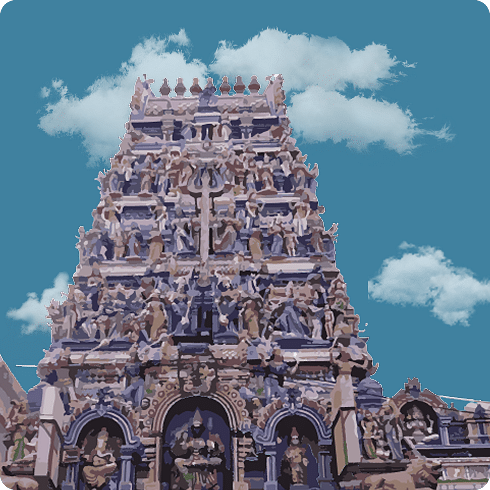
KAALIKAMBAL KAMADESWARAR TEMPLE ✨
Steeped in history and divine grace, the Kaalikambal Kamadeswarar Temple in Chennai stands as a sacred testament to time, once located near the sea before finding its home in Parry’s Corner in 1640 AD.
Distance from Grand Chennai10 km
Timing6:00 a.m. to 12:00 p.m.
4:00 p.m. to 9:00 p.m.FestivalAadi Pooram: (Aug)
Aadi Krithikai: (Aug)
Aadi Thirumanjanam: (Aug)
Ganesh Chathurthi: (Aug-Sep)
Navarathri: (Sep-Oct)
Skanda Shashti: In the Tamil month of Karthikai (Oct-Nov)
Thai month: (Jan)
Vasantha Urchavam: (Jul-Aug)
Thotti Unjal Urchavam: (Jul-Aug)Sacred Food OfferedPulisadam
Transportation CostFor assistance, please contact the front desk.
Disclaimer: The temple's timings are subject to change as per the operating committee's decisions.
About Kaalikambal Kamadeswarar Temple:
- The deity of Kaalikambal was once worshipped in a fierce form, which was later transformed into her calm and benevolent manifestation by Adi Shankara.
- Chhatrapati Shivaji, the great Maratha ruler, visited the temple in 1677, offering prayers and seeking divine blessings.
- The temple’s procession deity, Periyanayaki, is enshrined on a magnificent chariot, flanked by Goddess Mahalakshmi and Goddess Saraswati, representing prosperity and wisdom.
- The temple houses an evergreen mango tree, which serves as the sacred tree (sthala vriksha), believed to be a divine symbol of longevity and blessings.
- The sacred water source (sthala tirtha) is said to have a mystical connection with the sea, symbolising the confluence of spiritual and earthly realms.
- Tamil poet Subramaniya Bharathi frequented the temple, finding solace and inspiration for his poetry in its serene ambience.
- The temple hosts grand festivals such as Aadi Pooram, Aadi Krithikai, Ganesh Chathurthi, Navaratri, and Skanda Shashti, drawing thousands of devotees every year.
- The temple is known for its powerful spiritual vibrations, attracting sages, poets, and seekers who meditate and pray for divine grace.
- The temple is associated with the divine energies of Pancha Bhootha Sthalams, particularly Tiruvannamalai (Fire) and Kanchipuram (Earth), making it an important spiritual centre.
Divine Facts:
Long ago, the Kaalikambal Kamadeswarar Temple was home to a fierce and untamed goddess, radiating raw cosmic energy. It is believed that Adi Shankara, in his divine wisdom, calmed her form into the compassionate Shanta Swaroopa, offering solace to devotees ever since. When Chhatrapati Shivaji visited in 1677, he is said to have felt an overwhelming divine energy, strengthening his spirit before his future conquests. Similarly, Tamil poet Subramaniya Bharathi found inspiration within these sacred walls, as if the goddess herself whispered verses into his soul. The temple holds unique wonders—its sacred water (sthala tirtha) is believed to carry the sea’s spiritual essence, and its evergreen mango tree symbolises eternal wisdom. Those who step into this divine space feel their burdens lighten, as if embraced by the goddess’s infinite grace.VADAPALANI ANDAVAR TEMPLE ✨
Built in 1890, the Vadapalani Andavar Temple in Chennai is dedicated to Lord Muruga. What began as a thatched hut where Annaswami Nayakar worshipped grew into a grand temple.
Distance from Grand Chennai8 km
Timing5:00 a.m. to 12:30 p.m.
4:00 p.m. to 9:00 p.m.FestivalVaikasi Visakam: (May-Jun)
Thaipusam: (Jan-Feb)
Skanda Sashti: (Oct-Nov)
Theppotsavam: (Apr)
Panguni Uthiram: (Mar-Apr)Sacred Food OfferedPongal and Kesari
Transportation CostFor assistance, please contact the front desk.
Disclaimer: The temple's timings are subject to change as per the operating committee's decisions.
About Vadapalani Andavar Temple:
- The Vadapalani Murugan Temple was originally a humble thatched hut where Annaswami Nayakar worshipped a portrait of Lord Murugan.
- Over time, the temple grew into a grand sanctuary, attracting devotees, saints, and even film stars seeking divine blessings.
- The Rajagopuram, built in the 1920s, is adorned with intricate stucco sculptures depicting legends from the Skanda Purana.
- The architectural design is inspired by the Sundararaja Perumal Temple in Uthiramerur and follows the sacred Ashtanga Vimana style.
- Unlike other temples, Lord Murugan is depicted wearing footwear, signifying his readiness to come to his devotee's aid.
- The temple's golden chariot is a major attraction, drawing pilgrims who offer prayers and donations as a mark of devotion.
- The Thala Vriksham, a sacred fig tree within the temple, is believed to bless childless couples with progeny
- The eastern tower stands 40.8 metres tall, showcasing 108 Bharatnatyam dance postures, reflecting the deep cultural essence of the temple.
Divine Facts:
Long ago, in a humble hut, Annaswami Nayakar, an ardent devotee of Lord Murugan, endured a debilitating illness. One night, a sage appeared in his dream, revealing that Murugan’s divine presence dwelled within his home. Taking this as a divine sign, Annaswami travelled to Palani and was inexplicably drawn to a portrait of Murugan. Though he lacked the means to buy it, the shopkeeper, moved by an unseen force, handed it to him, declaring it was meant to be his. Back in Vadapalani, Annaswami worshipped the portrait with unwavering faith, and soon, miracles unfolded. His words became prophecies, guiding devotees through life's struggles. As people flocked to seek blessings, the sacred site transformed from a small hut into a revered temple, standing today as a beacon of faith, healing, and divine grace.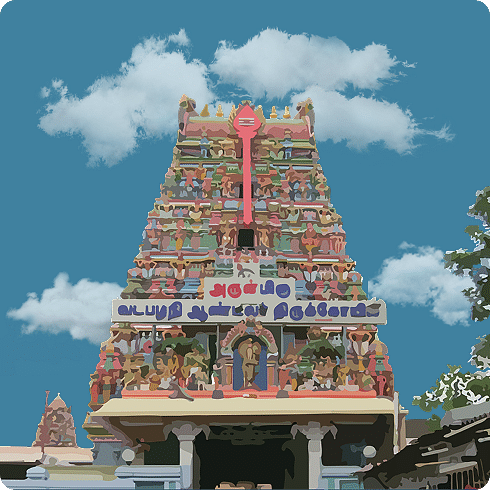
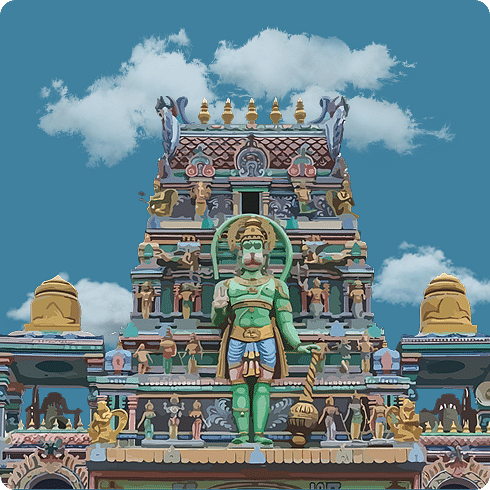
NANGANALLUR ANJANEYAR TEMPLE ✨
Established in 1989 by the Sri Maruti Bhakta Samajan Trust, this sacred site stands as a testament to faith, with its Kumbabishekam completed in 1995.
Distance from Radisson Blu3 km
Timing5:00 a.m. to 12:30 p.m.
4:30 p.m. to 9:00 p.m.FestivalHanuman Jayanthi: (Dec)
Sacred Food OfferedTamarind rice, Curd rice, and Vada mala.
Transportation CostFor assistance, please contact the front desk.
Disclaimer: The temple's timings are subject to change as per the operating committee's decisions.
About Anjaneya Temple, Nanganallur:
- The Anjaneya Temple in Nanganallur is renowned for its 32 ft. idol of Lord Hanuman, carved from a single granite stone.
- The temple was established in 1989 by the Sri Maruti Bhakta Samajan Trust and was opened to the public in 1995.
- Lord Hanuman is depicted in his Viswaroopa form, symbolising his immense power and unwavering devotion.
- The presence of Lord Rama and Lord Krishna within the temple signifies Hanuman’s role in both Ramayana and Mahabharata.
- Devotees believe that visiting this temple removes ailments and bestows strength, courage, and wisdom.
Divine Facts:
Long ago, when devotion was pure and prayers unwavering, a vision of Lord Hanuman, standing tall and radiant, came to a group of ardent devotees. Inspired by this divine calling, they sculpted his towering 32-foot form from a single rock, ensuring that his presence would forever bless those who sought his strength. Legends say that Hanuman himself chose this sacred spot, standing as a guardian for all who enter. Devotees who visit with true faith feel an unshakable sense of protection and courage, as if the mighty Vanara is whispering, ‘Fear not, I am with you’. Many believe that chanting his name here invokes miraculous healing and boundless energy, just as it did for warriors of ancient times.ISKCON TEMPLE, SHOLINGANALLUR ✨
A beacon of devotion and grandeur, ISKCON Temple in Sholinganallur is dedicated to Sri Radha Krishna, radiating divine love and spiritual serenity!
Distance from Radisson Blu22 km
Timing7:30 a.m. to 1:00 p.m.
4:00 p.m. to 9:00 p.m.FestivalVishu: (Apr)
Krishna Jayanthi: (Aug-Sep)Transportation CostFor assistance, please contact the front desk.
Disclaimer: The temple's timings are subject to change as per the operating committee's decisions.
About Iskcon Temple, Sholinganallur:
- ISKCON Chennai is part of a global network of over 500 ISKCON centres dedicated to spreading Krishna consciousness.
- The temple, built across five levels, features a grand 7,000 sq. ft. temple hall and an auditorium for cultural and spiritual events.
- Deities inside the temple were sculpted in Jaipur and Orissa, following traditional craftsmanship.
- The temple follows Pallava and Kalinga architectural styles, blending ancient aesthetics with spiritual significance.
- A stunning chandelier with 500 Himalayan quartz crystals enhances the spiritual aura, casting divine reflections throughout the temple.
- The entrance showcases a marble depiction of bhu-mandala, symbolising Vedic cosmology and the universe’s structure.
- The temple complex incorporates Vastu Shastra principles to harmonise spiritual and cosmic energies.
- A life-like statue of a cow nursing its calf at the entrance represents purity, nourishment, and divine protection.
Divine Facts:
Long ago, a saintly devotee had a vision—a divine sanctuary where Lord Krishna’s presence would be felt in every corner. Years later, that vision took form as the ISKCON Temple in Sholinganallur, its grand structure reflecting the celestial realms described in ancient scriptures. It is said that as one steps onto the marble bhu-mandala at the entrance, they symbolically walk through the cosmic universe, journeying towards spiritual awakening. The moment devotees enter, the air resonates with sacred chants, and the light from the magnificent Himalayan quartz chandelier dances across the ceiling, said to carry the energy of a thousand prayers. Many who visit claim to feel an unexplainable peace, as if Krishna himself watches over them, reminding all who enter that beyond the material world lies a realm of divine love and eternal joy.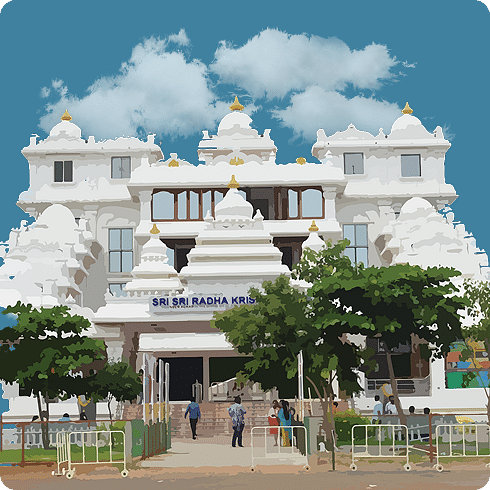
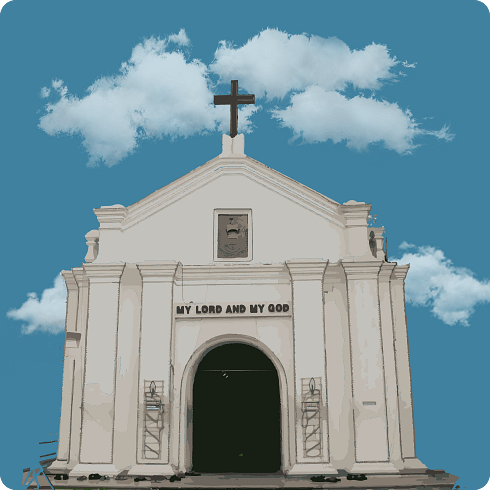
ST. THOMAS MOUNT CHURCH ✨
Established in 1523 and later declared a shrine in 2005, this sacred site is revered for its divine presence and healing grace.
Distance from Radisson Blu4 km
Timing6:10 a.m., 9:00 a.m.
12:00 p.m. to 5:30 p.m. (Children Hall)FestivalEaster: (Apr)
Transportation CostFor assistance, please contact the front desk.
Disclaimer: The church's timings are subject to change as per the operating committee's decisions.
About St.Thomas Mount Church:
- St. Thomas Church is one of only three churches in the world built over the tomb of an apostle of Jesus Christ, alongside St. Peter’s Basilica in Vatican City and Santiago de Compostela in Spain.
- The church's stunning Gothic-style architecture features intricate carvings, majestic arches, and towering columns, creating a divine atmosphere.
- St. Thomas is believed to have arrived in India in 52 AD, spreading the teachings of Christ before attaining martyrdom in Chennai.
- The church is a major pilgrimage site, attracting devotees from across the world, especially on St. Thomas Day (July 3), which is celebrated with special prayers and rituals.
- The serene surroundings, with lush greenery and peaceful courtyards, make it a haven for those seeking solace, meditation, and spiritual reflection.
Divine Facts:
Centuries ago, an apostle set foot on Indian soil, carrying the message of faith across unknown lands. St.Thomas, one of Christ’s twelve disciples, preached the Gospel in Tamil Nadu and performed miracles that strengthened the faith of his followers. However, his presence was not welcomed by all, and he was eventually martyred atop St.Thomas Mount. His final resting place became a beacon of hope, where a grand church now stands. As time passed, the church witnessed several transformations, reflecting the enduring devotion of believers. From its humble origins to the magnificent Gothic structure seen today, every stone tells a tale of faith and perseverance. To this day, pilgrims kneel before his tomb, whispering prayers of hope and healing, believing that the saint who once walked these lands still watches over them.
